
Buffalo, also known as bison, roam in various national parks and open spaces across North America. While they might look calm and majestic, they can be unpredictable if they feel threatened. So, let’s break down what you should do if you ever find yourself in this situation. Think of it as your handy guide for buffalo encounters!
Understanding Buffalo Behavior
Let’s start with a bit of buffalo 101. These animals can weigh over a thousand pounds and stand nearly six feet tall at the shoulder. So, when it comes to buffalo behavior, understanding how they react to their surroundings is key. They’re generally herbivores, spending their days munching on grass, which might give you the impression that they’re relaxed. But trust me, they’re also surprisingly quick and can charge at speeds up to 30 miles per hour!
You might be wondering, “How do I know if a buffalo is feeling threatened?” Buffalo are social animals, often seen in herds. If they feel cornered or perceive a threat, they might snort, paw at the ground, or even lower their heads. It’s essential to recognize these signals. They’re not just big cows—they have their own social structures and behaviors.
When you’re out in the wild, keep an eye on their body language. If they seem to be agitated or are vocalizing, it’s your cue to maintain your distance. Understanding these cues can make all the difference in a potentially dangerous encounter.
Staying Calm and Observing
Alright, let’s say you spot a buffalo in the wild. Your first instinct might be to snap a photo or get closer for a better look. But here’s the thing: calmness is key. Instead of rushing in with your camera, take a moment to observe from a safe distance. Wild animals are unpredictable, and they can sense your energy. If you appear calm and non-threatening, they’re more likely to ignore you.
Find a spot where you can watch the buffalo without getting too close. Use binoculars for a better view if you have them! This way, you can enjoy the beauty of these animals while keeping safe. Remember, it’s their home, and you’re just a visitor.
If you’re with friends or family, make sure to communicate quietly. Loud noises or sudden movements can startle the buffalo and lead to unwanted reactions. Keeping a calm group will help maintain the overall peaceful atmosphere.
Maintaining Distance is Crucial
One of the most important rules when encountering wildlife is to always maintain a safe distance. For buffalo, the general recommendation is to stay at least 25-100 yards away. That might sound far, but it’s necessary for both your safety and the buffalo’s.
Why is distance so important? Imagine if someone walked too close to you while you were eating—how would you feel? Buffalo can become defensive, especially if they have calves nearby. They see you as a potential threat, and that’s when things can get hairy. So, pull out your phone or camera and use zoom features instead of moving closer.
In national parks, there are usually clear guidelines about how far to stay from wildlife. Trust me, those rules are there for a good reason. Stick to the paths and follow the park’s instructions to minimize any risk.
What to Do if a Buffalo Approaches
Let’s say you’re standing at a safe distance, and suddenly, a buffalo starts walking towards you. Honestly, don’t panic! The first thing to do is to remain still and calm. Moving suddenly or trying to run can provoke a charge.
Here’s a step-by-step on how to handle this:
- Stay Put: Don’t run—this can trigger a chase response.
- Observe: Keep an eye on the buffalo’s movements. It’s likely just curious.
- Back Away Slowly: If you feel it’s getting too close, back away slowly while facing the animal. Sudden movements can startle it.
- Find Shelter: If a buffalo becomes aggressive, look for a large tree, rock, or any natural barrier to put between you and the buffalo.
These steps can help keep you safe if a buffalo seems interested in your presence. Remember, being confident and non-threatening goes a long way.
Respecting Buffalo and Their Habitat
While it’s thrilling to see buffalo in the wild, it’s crucial to respect their space and habitat. Buffalo play an essential role in their ecosystem, helping to manage grasslands by grazing. They’re not just part of the scenery; they contribute to biodiversity.
You might be wondering how to respect them further. One way is to minimize your impact on their environment. Always leave no trace by following park rules, staying on designated trails, and not feeding the wildlife. Feeding buffalo can lead them to associate humans with food, which isn’t safe for either party.
Moreover, when you visit a park, take time to educate yourself about the local wildlife and their needs. When you respect their home, you’re not just being a responsible visitor; you’re helping preserve it for future generations.
Preparing for Your Wild Encounter
Planning ahead is always smart, especially if you know you’ll be in buffalo territory. Make sure you have essentials that will help you in an encounter. Here’s what you should consider bringing:
- Binoculars: Great for observing from a distance.
- Camera: Capture the moment without getting too close.
- Map: Know the area and any specific guidelines for wildlife.
- Safety Whistle: This can be useful for signaling help if needed.
Having a plan means you can enjoy your time in nature without unnecessary worries. Knowledge is your best friend when encountering wildlife. Knowing what to expect and how to react is invaluable.
Final Thoughts on Buffalo Encounters
So, there you have it. Encountering a buffalo in the wild can be an awe-inspiring experience, but it’s one that comes with responsibility. By understanding their behavior, keeping a safe distance, and respecting their habitat, you can ensure both your safety and the well-being of these magnificent animals.
Next time you head out into nature, remember these tips. You’ll have a better chance of enjoying a peaceful encounter with buffalo while having a fantastic adventure. Just keep your distance, stay calm, and enjoy the wild beauty around you. Happy exploring!

